tires TOYOTA COROLLA 2020 Owners Manual (in English)
[x] Cancel search | Manufacturer: TOYOTA, Model Year: 2020, Model line: COROLLA, Model: TOYOTA COROLLA 2020Pages: 588, PDF Size: 13.49 MB
Page 5 of 588
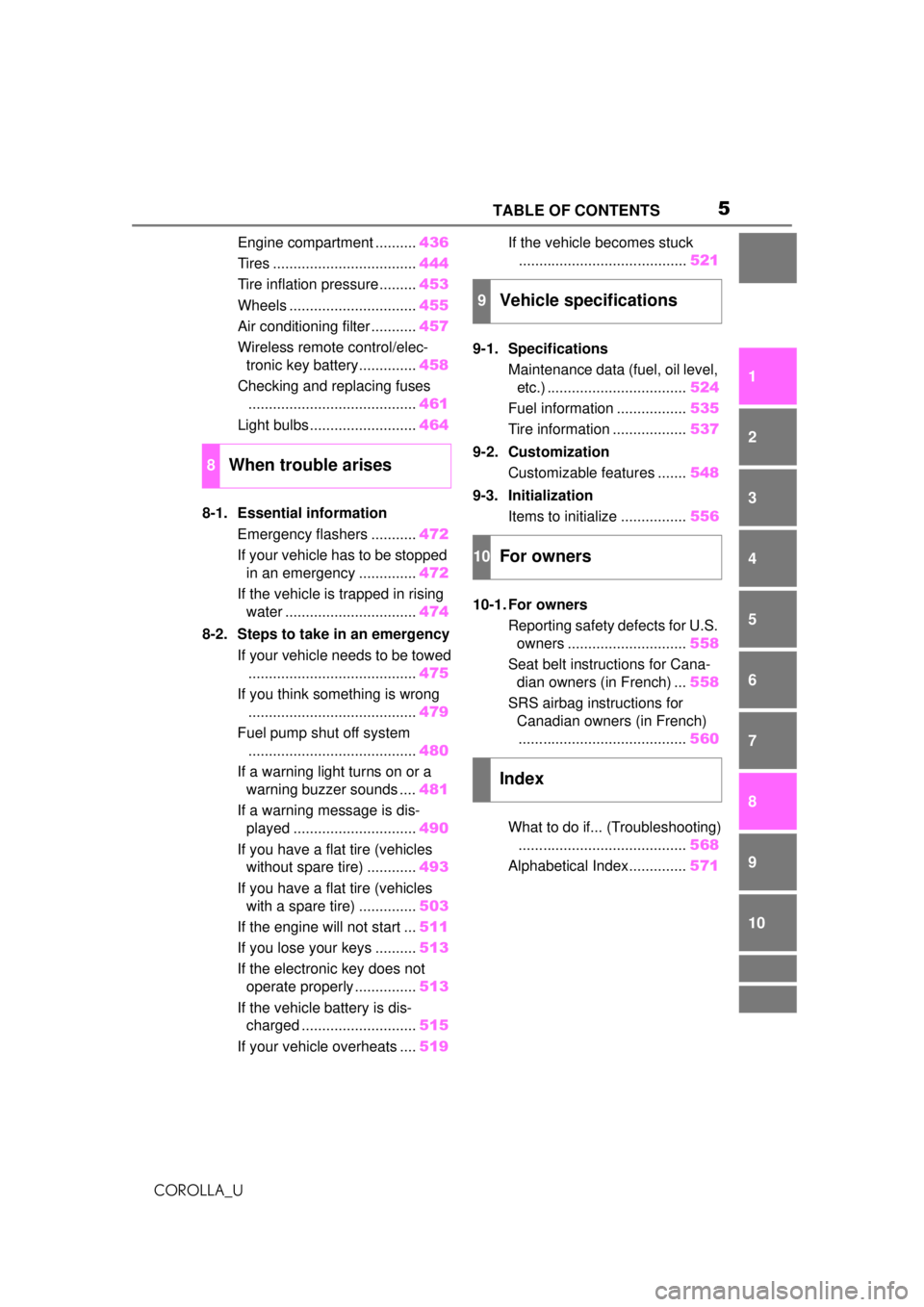
5TABLE OF CONTENTS
COROLLA_U
1
2
3
4
5
6
7
8
9
10
Engine compartment .......... 436
Tires ................................... 444
Tire inflation pressure......... 453
Wheels ............................... 455
Air conditioning filter ........... 457
Wireless remote control/elec- tronic key battery.............. 458
Checking and replacing fuses ......................................... 461
Light bulbs .......................... 464
8-1. Essential information Emergency flashers ........... 472
If your vehicle has to be stopped in an emergency .............. 472
If the vehicle is trapped in rising water ................................ 474
8-2. Steps to take in an emergency If your vehicle needs to be towed......................................... 475
If you think something is wrong ......................................... 479
Fuel pump shut off system ......................................... 480
If a warning light turns on or a warning buzzer sounds .... 481
If a warning message is dis- played .............................. 490
If you have a flat tire (vehicles without spare tire) ............ 493
If you have a flat tire (vehicles with a spare tire) .............. 503
If the engine will not start ... 511
If you lose your keys .......... 513
If the electronic key does not operate properly ............... 513
If the vehicle battery is dis- charged ............................ 515
If your vehicle overheats .... 519If the vehicle becomes stuck
......................................... 521
9-1. Specifications Maintenance data (fuel, oil level, etc.) .................................. 524
Fuel information ................. 535
Tire information .................. 537
9-2. Customization Customizable features ....... 548
9-3. Initialization Items to initialize ................ 556
10-1. For owners Reporting safety defects for U.S. owners ............................. 558
Seat belt instructions for Cana- dian owners (in French) ... 558
SRS airbag instructions for Canadian owners (in French)......................................... 560
What to do if... (Troubleshooting) ......................................... 568
Alphabetical Index.............. 571
8When trouble arises
9Vehicle specifications
10For owners
Index
Page 13 of 588
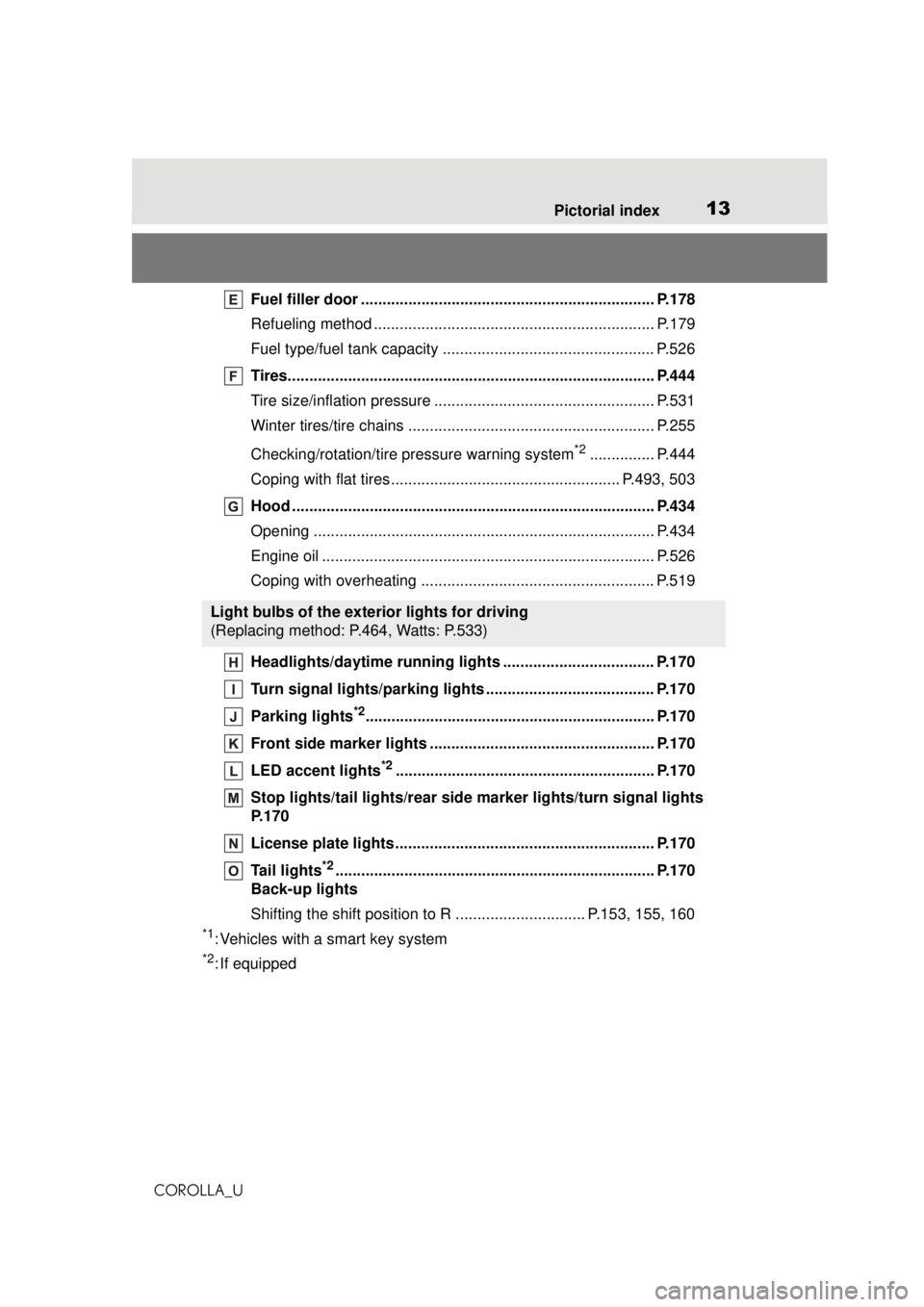
13Pictorial index
COROLLA_U
Fuel filler door .................................................................... P.178
Refueling method ................................................................. P.179
Fuel type/fuel tank capacity ................................................. P.526
Tires..................................................................................... P.444
Tire size/inflation pressure ................................................... P.531
Winter tires/tire chains ......................................................... P.255
Checking/rotation/tire pressure warning system
*2............... P.444
Coping with flat tires..................................................... P.493, 503
Hood .................................................................................... P.434
Opening ............................................................................... P.434
Engine oil ............................................................................. P.526
Coping with overheating ...................................................... P.519
Headlights/daytime running lights ................................... P.170
Turn signal lights/parking lights ....................................... P.170
Parking lights
*2................................................................... P.170
Front side marker lights .................................................... P.170
LED accent lights
*2............................................................ P.170
Stop lights/tail lights/rear side marker lights/turn signal lights
P. 1 7 0
License plate lights............................................................ P.170
Tail lights
*2.......................................................................... P.170
Back-up lights
Shifting the shift position to R .............................. P.153, 155, 160
*1: Vehicles with a smart key system
*2: If equipped
Light bulbs of the exterior lights for driving
(Replacing method: P.464, Watts: P.533)
Page 135 of 588

1354-1. Before driving
COROLLA_U
4
Driving
4 Slowly release the brake
pedal.
5 Lock the door, making sure
that you have the key on your
person.
If parking on a hill, block the wheels
as needed.
ïµManual transmission
1 While depressing the clutch
pedal, depress the brake
pedal.
2 Set the parking brake.
(ï® P.163, 164)
Check that the parking brake indi-
cator is illuminated.
3Shift the shift lever to N.
(ï® P.160)
If parking on a hill, shift the shift
lever to 1 or R and block the wheels
as needed.
4Vehicles without a smart key
system: Turn the engine
switch to OFF to stop the
engine.
Vehicles with a smart key
system: Press the engine
switch to stop the engine.
5 Slowly release the brake
pedal.
6 Lock the door, making sure
that you have the key on your
person.
â Starting off on a steep
uphill
ïµContinuously variable trans-
mission
1 Make sure that the parking
brake is set and shift the shift
lever to D.
Hill-start assist control will operate.
(ï® P.251)
2 Gently depress the accelera-
tor pedal.
3 Release the parking brake.
ïµManual transmission
1 Make sure that the parking
brake is set and shift the shift
lever to 1.
Hill-start assist control will operate.
(ï® P.251)
2 Lightly depress the accelera-
tor pedal at the same time as
gradually releasing the clutch
pedal.
3 Release the parking brake.
â Driving in the rain
âDrive carefully when it is raining,
because visibility will be reduced,
the windows may become
fogged-up, and the road will be
slippery.
âDrive carefully when it starts to
rain, because the road surface will
be especially slippery.
âRefrain from high speeds when
driving on an expressway in the
rain, because there may be a
layer of water between the tires
and the road surface, preventing
the steering and brakes from
operating properly.
Page 138 of 588
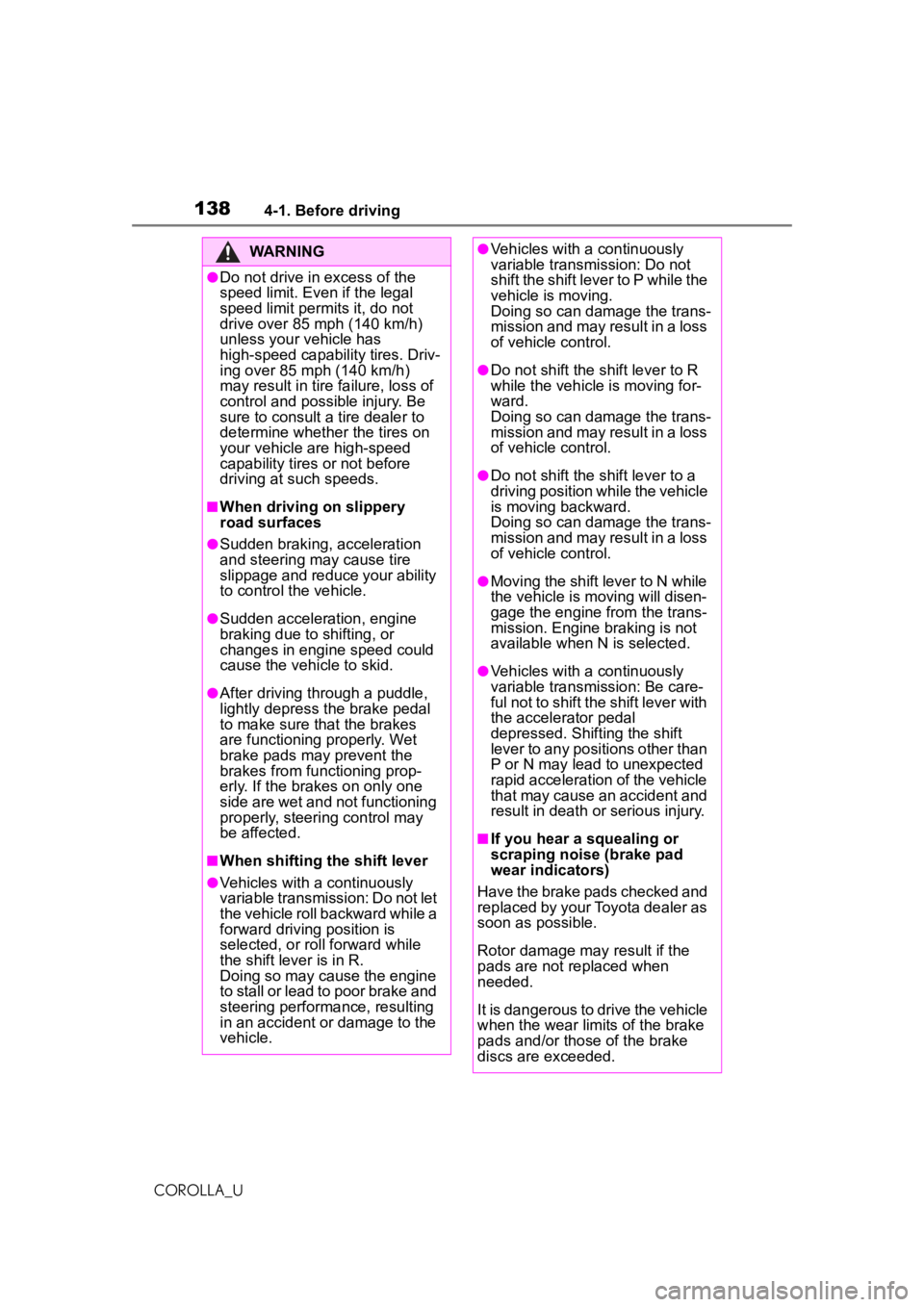
1384-1. Before driving
COROLLA_U
WARNING
âDo not drive in excess of the
speed limit. Even if the legal
speed limit permits it, do not
drive over 85 mph (140 km/h)
unless your vehicle has
high-speed capability tires. Driv-
ing over 85 mph (140 km/h)
may result in tire failure, loss of
control and possible injury. Be
sure to consult a tire dealer to
determine whether the tires on
your vehicle are high-speed
capability tires or not before
driving at such speeds.
â When driving on slippery
road surfaces
âSudden braking, acceleration
and steering may cause tire
slippage and reduce your ability
to control the vehicle.
âSudden acceleration, engine
braking due to shifting, or
changes in engine speed could
cause the vehicle to skid.
âAfter driving through a puddle,
lightly depress the brake pedal
to make sure that the brakes
are functioning properly. Wet
brake pads may prevent the
brakes from functioning prop-
erly. If the brakes on only one
side are wet and not functioning
properly, steering control may
be affected.
â When shifting the shift lever
âVehicles with a continuously
variable transmission: Do not let
the vehicle roll backward while a
forward driving position is
selected, or ro ll forward while
the shift lever is in R.
Doing so may cause the engine
to stall or lead to poor brake and
steering performance, resulting
in an accident or damage to the
vehicle.
âVehicles with a continuously
variable transmission: Do not
shift the shift lever to P while the
vehicle is moving.
Doing so can damage the trans-
mission and may result in a loss
of vehicle control.
âDo not shift the shift lever to R
while the vehicle is moving for-
ward.
Doing so can damage the trans-
mission and may result in a loss
of vehicle control.
âDo not shift the shift lever to a
driving position while the vehicle
is moving backward.
Doing so can damage the trans-
mission and may result in a loss
of vehicle control.
âMoving the shift lever to N while
the vehicle is moving will disen-
gage the engine from the trans-
mission. Engine braking is not
available when N is selected.
âVehicles with a continuously
variable transmission: Be care-
ful not to shift the shift lever with
the accelerator pedal
depressed. Shifting the shift
lever to any positions other than
P or N may lead to unexpected
rapid acceleration of the vehicle
that may cause an accident and
result in death or serious injury.
â If you hear a squealing or
scraping noise (brake pad
wear indicators)
Have the brake pads checked and
replaced by your Toyota dealer as
soon as possible.
Rotor damage may result if the
pads are not replaced when
needed.
It is dangerous to drive the vehicle
when the wear limits of the brake
pads and/or those of the brake
discs are exceeded.
Page 145 of 588
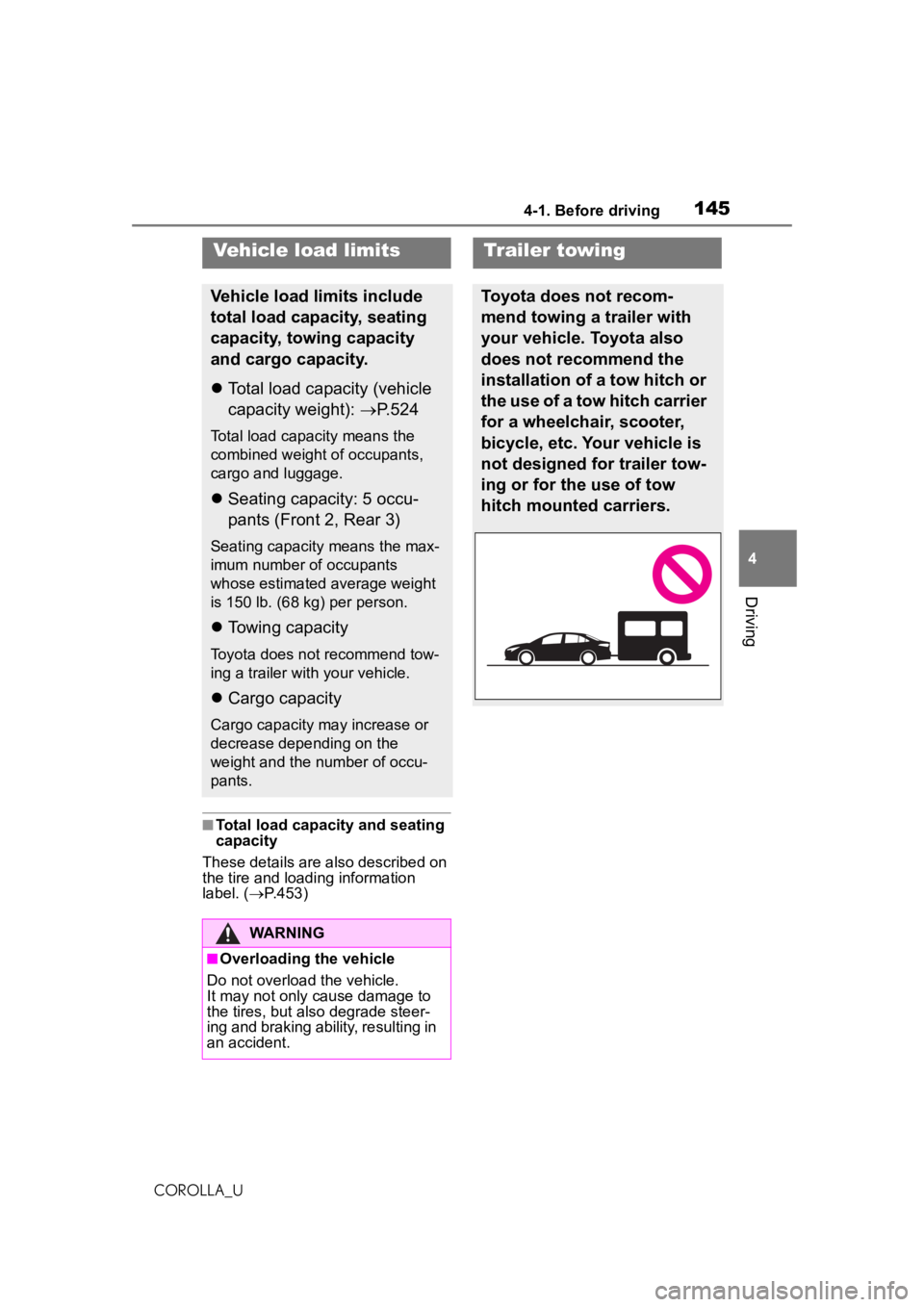
1454-1. Before driving
COROLLA_U
4
Driving
â Total load capacity and seating
capacity
These details are also described on
the tire and loading information
label. ( ï®P.453)
Vehicle load limits
Vehicle load limits include
total load capacity, seating
capacity, towing capacity
and cargo capacity.
ï¬ Total load capacity (vehicle
capacity weight): ï®P.524
Total load capacity means the
combined weight of occupants,
cargo and luggage.
ï¬ Seating capacity: 5 occu-
pants (Front 2, Rear 3)
Seating capacity means the max-
imum number of occupants
whose estimated average weight
is 150 lb. (68 kg) per person.
ï¬Towing capacity
Toyota does not recommend tow-
ing a trailer with your vehicle.
ï¬Cargo capacity
Cargo capacity may increase or
decrease depending on the
weight and the number of occu-
pants.
WARNING
â Overloading the vehicle
Do not overload the vehicle.
It may not only cause damage to
the tires, but also degrade steer-
ing and braking ability, resulting in
an accident.
Trailer towing
Toyota does not recom-
mend towing a trailer with
your vehicle. Toyota also
does not recommend the
installation of a tow hitch or
the use of a tow hitch carrier
for a wheelchair, scooter,
bicycle, etc. Your vehicle is
not designed for trailer tow-
ing or for the use of tow
hitch mounted carriers.
Page 169 of 588
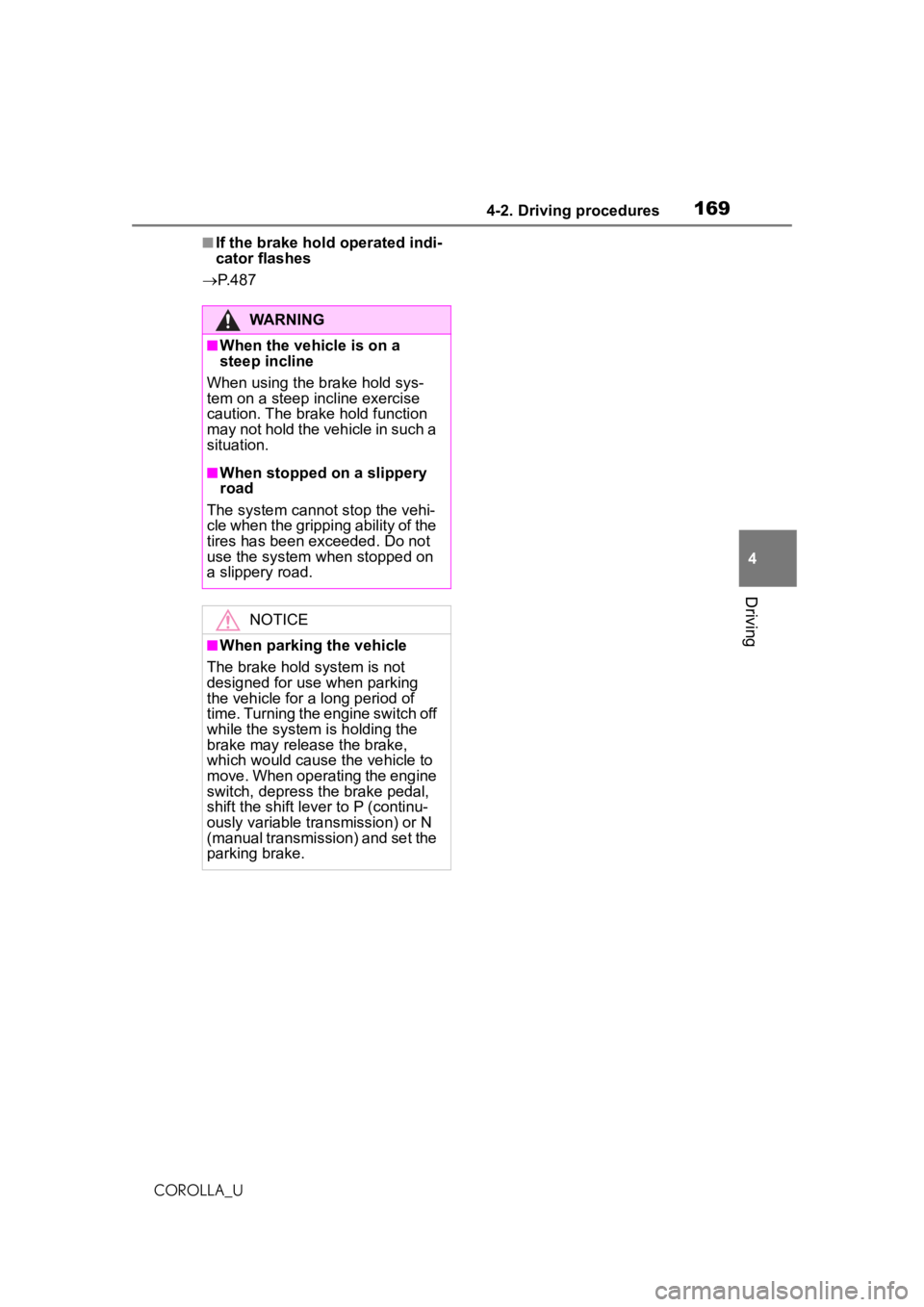
1694-2. Driving procedures
COROLLA_U
4
Driving
â If the brake hold operated indi-
cator flashes
ï® P. 4 8 7
WARNING
â When the vehicle is on a
steep incline
When using the brake hold sys-
tem on a steep incline exercise
caution. The brake hold function
may not hold the vehicle in such a
situation.
â When stopped on a slippery
road
The system cannot stop the vehi-
cle when the gripping ability of the
tires has been exceeded. Do not
use the system when stopped on
a slippery road.
NOTICE
â When parking the vehicle
The brake hold system is not
designed for use when parking
the vehicle for a long period of
time. Turning the engine switch off
while the system is holding the
brake may release the brake,
which would cause the vehicle to
move. When operating the engine
switch, depress the brake pedal,
shift the shift lever to P (continu-
ously variable transmission) or N
(manual transmission) and set the
parking brake.
Page 189 of 588
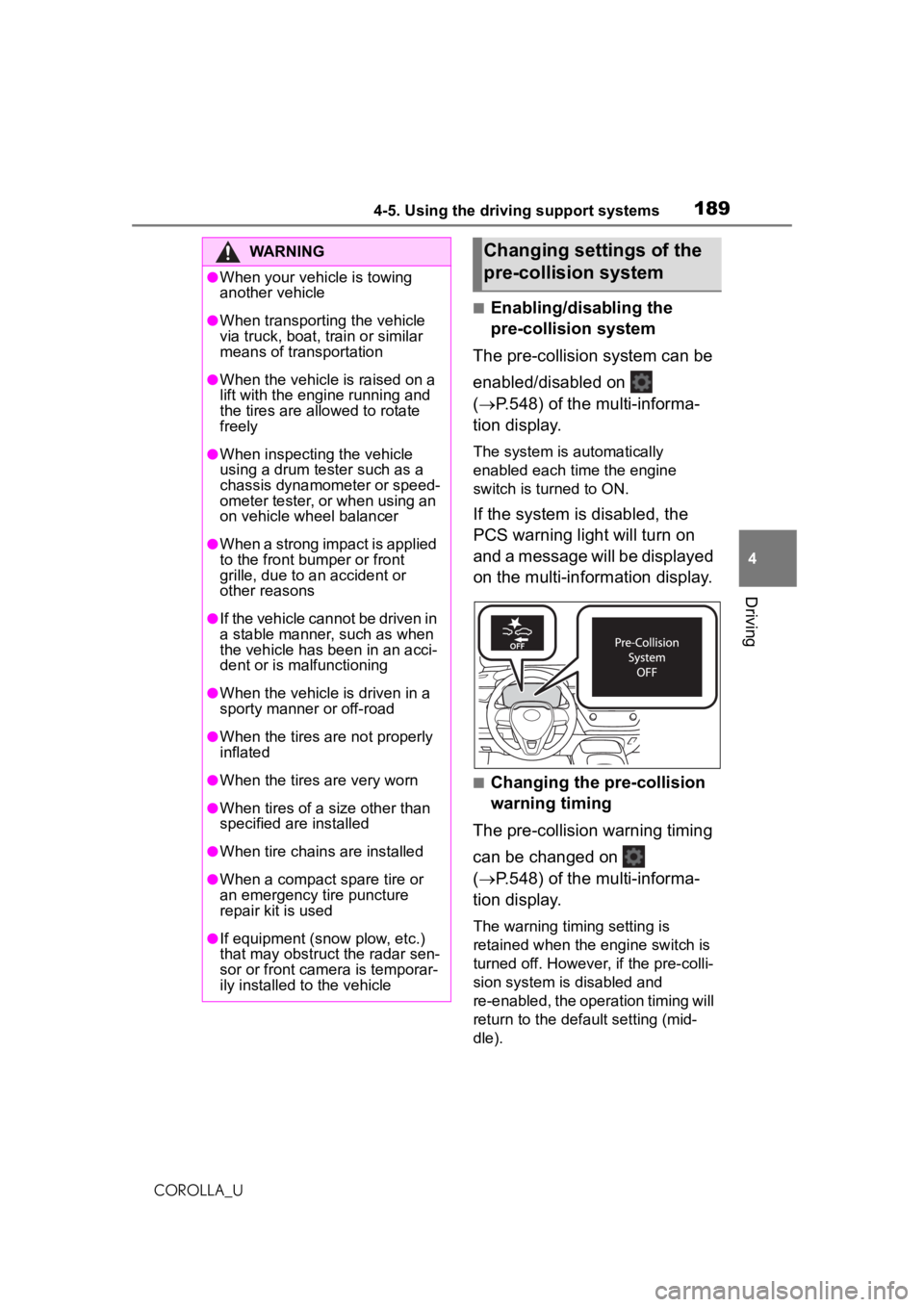
1894-5. Using the driving support systems
COROLLA_U
4
Driving
â Enabling/disabling the
pre-collision system
The pre-collision system can be
enabled/disabled on
(ï® P.548) of the multi-informa-
tion display.
The system is automatically
enabled each time the engine
switch is turned to ON.
If the system is disabled, the
PCS warning light will turn on
and a message will be displayed
on the multi-information display.
â Changing the pre-collision
warning timing
The pre-collision warning timing
can be changed on
(ï® P.548) of the multi-informa-
tion display.
The warning timing setting is
retained when the engine switch is
turned off. However, if the pre-colli-
sion system is disabled and
re-enabled, the operation timing will
return to the default setting (mid-
dle).
WARNING
âWhen your vehicle is towing
another vehicle
âWhen transporting the vehicle
via truck, boat, train or similar
means of transportation
âWhen the vehicle is raised on a
lift with the engine running and
the tires are allowed to rotate
freely
âWhen inspecting the vehicle
using a drum tester such as a
chassis dynamometer or speed-
ometer tester, or when using an
on vehicle wheel balancer
âWhen a strong impact is applied
to the front bumper or front
grille, due to an accident or
other reasons
âIf the vehicle cannot be driven in
a stable manner, such as when
the vehicle has been in an acci-
dent or is malfunctioning
âWhen the vehicle is driven in a
sporty manner or off-road
âWhen the tires are not properly
inflated
âWhen the tires are very worn
âWhen tires of a size other than
specified are installed
âWhen tire chains are installed
âWhen a compact spare tire or
an emergency tire puncture
repair kit is used
âIf equipment (snow plow, etc.)
that may obstruct the radar sen-
sor or front camera is temporar-
ily installed to the vehicle
Changing settings of the
pre-collision system
Page 194 of 588
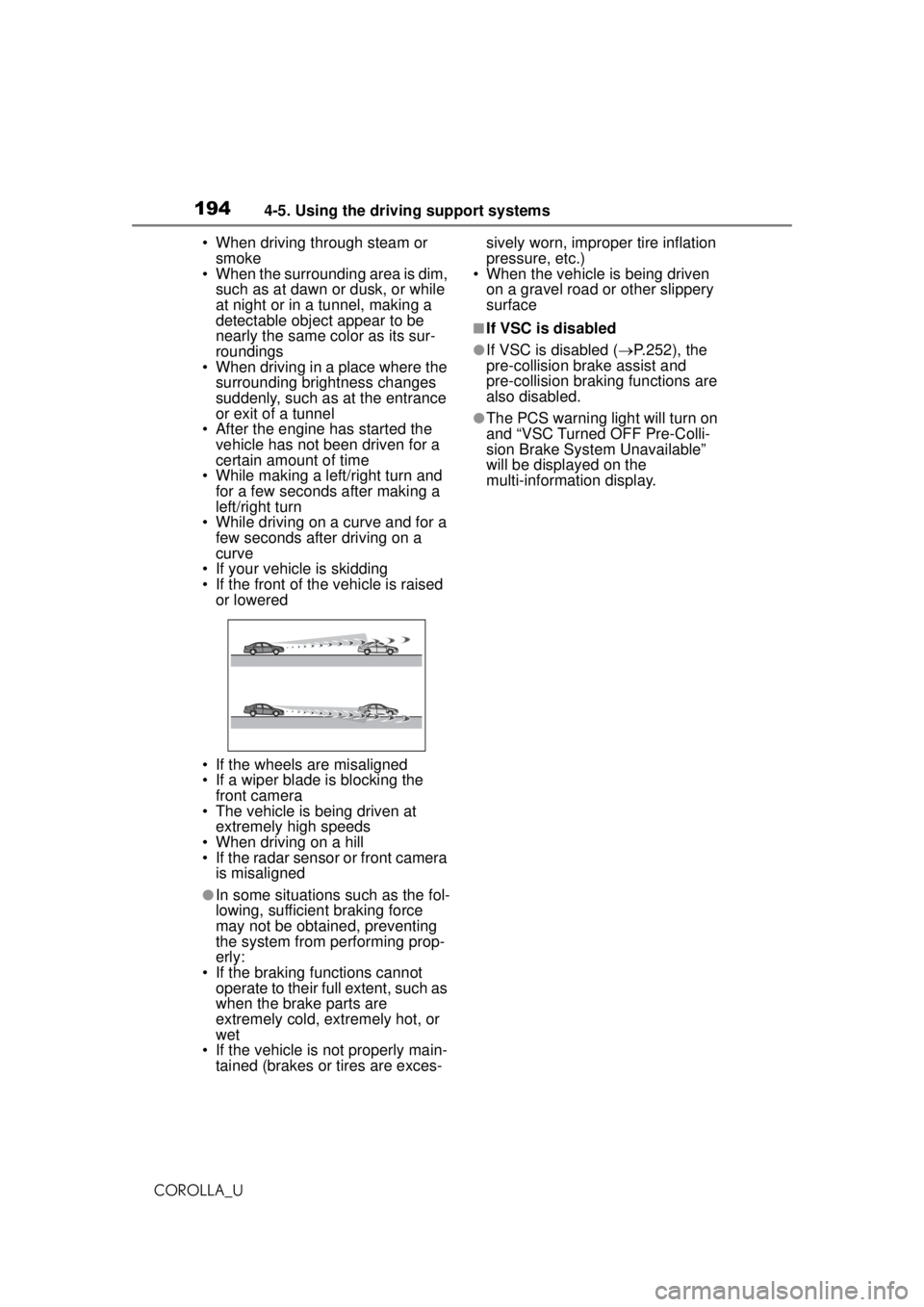
1944-5. Using the driving support systems
COROLLA_U⢠When driving through steam or
smoke
⢠When the surrounding area is dim,
such as at dawn or dusk, or while
at night or in a tunnel, making a
detectable object appear to be
nearly the same color as its sur-
roundings
⢠When driving in a place where the
surrounding brightness changes
suddenly, such as at the entrance
or exit of a tunnel
⢠After the engine has started the vehicle has not been driven for a
certain amount of time
⢠While making a left/right turn and for a few seconds after making a
left/right turn
⢠While driving on a curve and for a few seconds after driving on a
curve
⢠If your vehicle is skidding
⢠If the front of the vehicle is raised or lowered
⢠If the wheels are misaligned
⢠If a wiper blade is blocking the front camera
⢠The vehicle is being driven at extremely high speeds
⢠When driving on a hill
⢠If the radar sensor or front camera is misaligned
âIn some situations such as the fol-
lowing, sufficient braking force
may not be obtained, preventing
the system from performing prop-
erly:
⢠If the braking functions cannot operate to their full extent, such as
when the brake parts are
extremely cold, extremely hot, or
wet
⢠If the vehicle is not properly main- tained (brakes or tires are exces- sively worn, improper tire inflation
pressure, etc.)
⢠When the vehicle is being driven
on a gravel road or other slippery
surface
â If VSC is disabled
âIf VSC is disabled ( ï®P.252), the
pre-collision brake assist and
pre-collision braking functions are
also disabled.
âThe PCS warning light will turn on
and âVSC Turned OFF Pre-Colli-
sion Brake System Unavailableâ
will be displayed on the
multi-information display.
Page 196 of 588
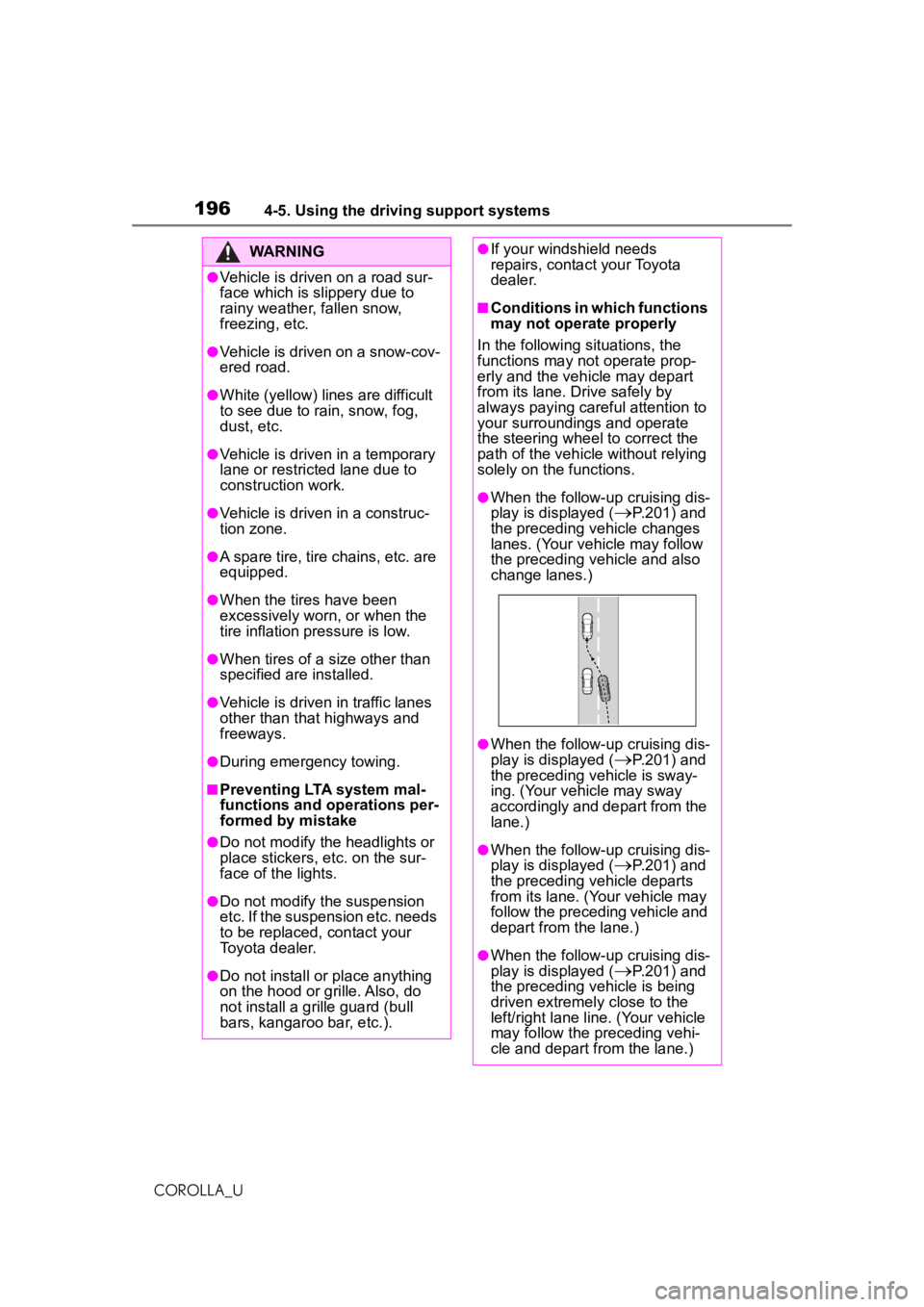
1964-5. Using the driving support systems
COROLLA_U
WARNING
âVehicle is driven on a road sur-
face which is slippery due to
rainy weather, fallen snow,
freezing, etc.
âVehicle is driven on a snow-cov-
ered road.
âWhite (yellow) lines are difficult
to see due to rain, snow, fog,
dust, etc.
âVehicle is driven in a temporary
lane or restricted lane due to
construction work.
âVehicle is driven in a construc-
tion zone.
âA spare tire, tire chains, etc. are
equipped.
âWhen the tires have been
excessively worn, or when the
tire inflation pressure is low.
âWhen tires of a size other than
specified are installed.
âVehicle is driven in traffic lanes
other than that highways and
freeways.
âDuring emergency towing.
â Preventing LTA system mal-
functions and operations per-
formed by mistake
âDo not modify the headlights or
place stickers, etc. on the sur-
face of the lights.
âDo not modify the suspension
etc. If the suspension etc. needs
to be replaced, contact your
Toyota dealer.
âDo not install or place anything
on the hood or grille. Also, do
not install a grille guard (bull
bars, kangaroo bar, etc.).
âIf your windshield needs
repairs, contact your Toyota
dealer.
â Conditions in which functions
may not operate properly
In the following situations, the
functions may not operate prop-
erly and the vehicle may depart
from its lane. Drive safely by
always paying careful attention to
your surroundings and operate
the steering wheel to correct the
path of the vehicle without relying
solely on the functions.
âWhen the follow-up cruising dis-
play is displayed (
ï®P.201) and
the preceding vehicle changes
lanes. (Your vehicle may follow
the preceding vehicle and also
change lanes.)
âWhen the follow-up cruising dis-
play is displayed (
ï®P.201) and
the preceding vehicle is sway-
ing. (Your vehicle may sway
accordingly and depart from the
lane.)
âWhen the follow-up cruising dis-
play is displayed (
ï®P.201) and
the preceding vehicle departs
from its lane. (Your vehicle may
follow the preceding vehicle and
depart from the lane.)
âWhen the follow-up cruising dis-
play is displayed (
ï®P.201) and
the preceding vehicle is being
driven extremely close to the
left/right lane line. (Your vehicle
may follow the preceding vehi-
cle and depart from the lane.)
Page 198 of 588
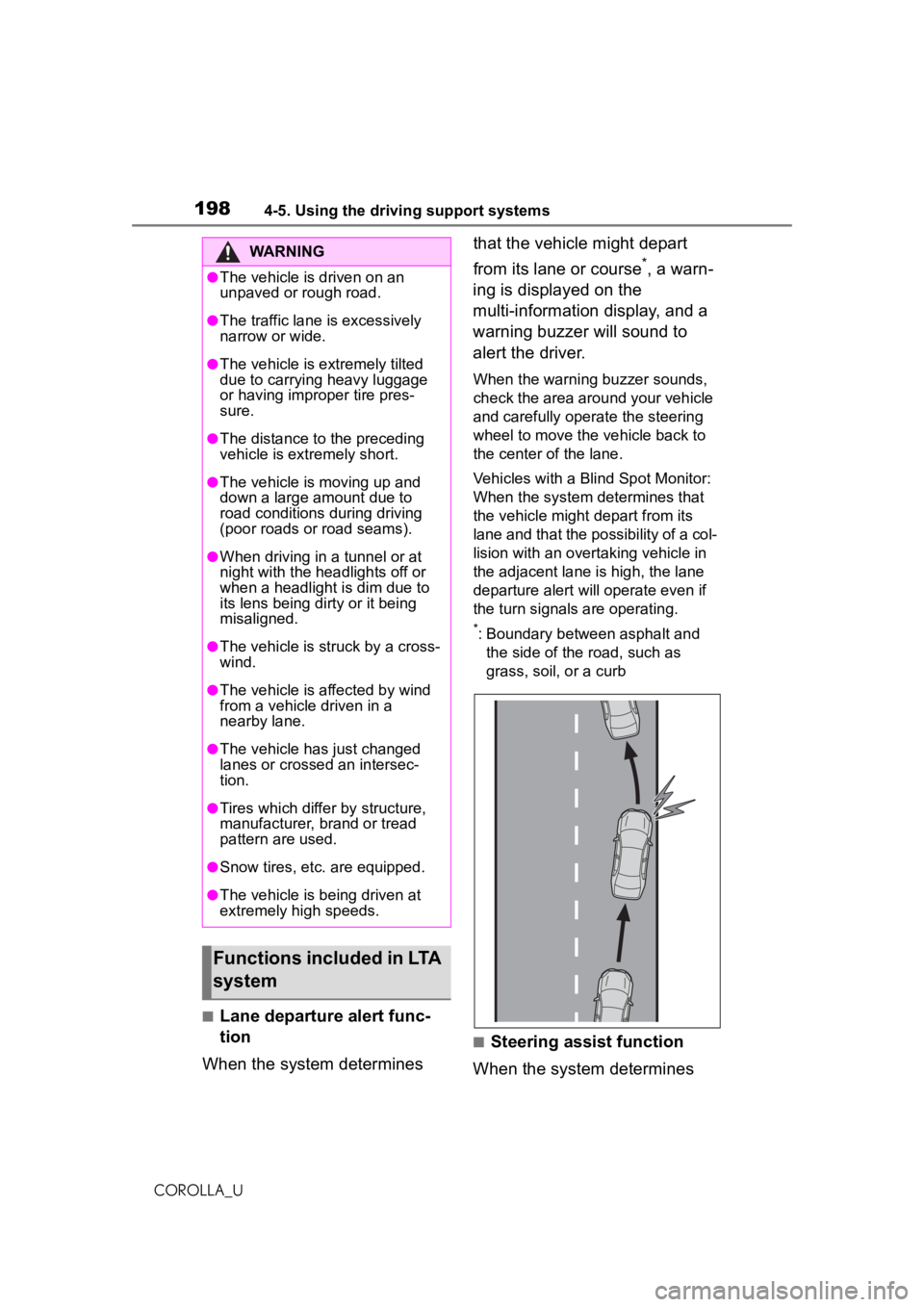
1984-5. Using the driving support systems
COROLLA_U
â Lane departure alert func-
tion
When the system determines that the vehicle might depart
from its lane or course
*, a warn-
ing is displayed on the
multi-information display, and a
warning buzzer will sound to
alert the driver.
When the warning buzzer sounds,
check the area around your vehicle
and carefully operate the steering
wheel to move the vehicle back to
the center of the lane.
Vehicles with a Blind Spot Monitor:
When the system determines that
the vehicle might depart from its
lane and that the possibility of a col-
lision with an overtaking vehicle in
the adjacent lane is high, the lane
departure alert will operate even if
the turn signals are operating.
*: Boundary between asphalt and the side of the road, such as
grass, soil, or a curb
â Steering assist function
When the system determines
WARNING
âThe vehicle is driven on an
unpaved or rough road.
âThe traffic lane is excessively
narrow or wide.
âThe vehicle is extremely tilted
due to carrying heavy luggage
or having improper tire pres-
sure.
âThe distance to the preceding
vehicle is extremely short.
âThe vehicle is moving up and
down a large amount due to
road conditions during driving
(poor roads or road seams).
âWhen driving in a tunnel or at
night with the headlights off or
when a headlight is dim due to
its lens being dirty or it being
misaligned.
âThe vehicle is struck by a cross-
wind.
âThe vehicle is affected by wind
from a vehicle driven in a
nearby lane.
âThe vehicle has just changed
lanes or crossed an intersec-
tion.
âTires which differ by structure,
manufacturer, brand or tread
pattern are used.
âSnow tires, etc. are equipped.
âThe vehicle is being driven at
extremely high speeds.
Functions included in LTA
system